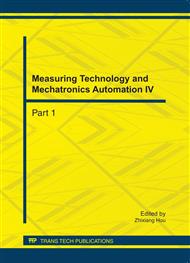[1]
Piella G. A General Framework for Multi-resolution Image Fusion: from Pixels to Regions. Information Fusion, 5(4): 259-280, (2003).
DOI: 10.1016/s1566-2535(03)00046-0
Google Scholar
[2]
Liu K, Guo L, Li H, Chen J. Fusion of Infrared and Visible Light Images Based on Region Segmentation. Chinese Journal of Aeronautics. 22(9): 75-80, (2009).
DOI: 10.1016/s1000-9361(08)60071-0
Google Scholar
[3]
Yin, S., Cao, L., Ling, Y. & Jin, G. One color contrast enhanced infrared and visible image fusion method. Infrared Physics & Technology, 53(2): 146-150, (2010).
DOI: 10.1016/j.infrared.2009.10.007
Google Scholar
[4]
Hong L, He Z, Xiang J, Li S. Fusion of Infrared and Visible Image Based On Genetic Algorithm and Data Assimilation, Proc. of ISA 2009: 1-5. (2009).
DOI: 10.1109/iwisa.2009.5072875
Google Scholar
[5]
Liu J, Wang Q, Chen Y. Comparisons of Several Pixel-Level Image Fusion Schemes for Infrared and Visible Light Images, Proc. of IMTC 2005, Ottawa, Canada: 2024-2027. (2005).
DOI: 10.1109/imtc.2005.1604528
Google Scholar
[6]
Zhang X, Chen Q, Men T. Comparison of Fusion Methods for the Infrared and Color Visible Images, Proc. of ICCSIT 2009: 421-424. (2009).
Google Scholar
[7]
Yao F, Sekmen A. Multi-source Airborne IR and Optical Image Fusion and Its Application to Target Detection. Proceeding of ISVC 2008, Part II, LNCS 5359, 651-660. (2008).
DOI: 10.1007/978-3-540-89646-3_64
Google Scholar
[8]
Yao F, Shao G, Sekmen A et al. Real-time Multiple Moving Targets Detection from Airborne IR Imagery by Dynamic Gabor Filter and Dynamic Gaussian Detector, EURASIP Journal on Image and Video Processing, September, pp.1-22. (2010).
DOI: 10.1155/2010/124681
Google Scholar
[9]
Xu S, Niu Y, Shen L, et al. Real-time Moving target detection method form unmanned airborne camera image. Computer Engineering, 36(s): 271-273. (2010) (in Chinese).
Google Scholar
[10]
Burt P J, Kolczynski R J. Enhanced Image Capture through Fusion: Proceeding of the 4th International Conference on Computer Vision, Berlin, Germany, 5: 173-182. (1993).
DOI: 10.1109/iccv.1993.378222
Google Scholar
[11]
Huang W, Jing Z. Evaluation of focus measures in multifocus image fusion. Pattern Recognition Letters, 28(4): 493-500. (2007).
DOI: 10.1016/j.patrec.2006.09.005
Google Scholar


